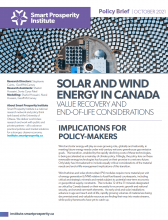Wind and solar energy will play an ever-growing role, globally and nationally, in meeting future energy needs under mid-century net-zero greenhouse gas emission goals. Fittingly, the policy lens on these renewable energy technologies has focused on their promise in a net-zero future. Only lately has it broadened to include equally critical considerations of the material needs and end-of-life management implications of this transition.
Solar PV modules and wind turbines use common materials such as glass, iron, steel and aluminum, but also critical and strategic minerals and metals subject to potential near-term economic or geopolitical supply constraints. This includes 13 of the 31 minerals designated as critical by Canada based on their necessity for economic growth and national security, plus four rare-earth elements. As early wind and solar installations advance in age and are decommissioned, these materials are beginning to find their way into waste streams, while policy frameworks have yet to catch up.
This report represents a first effort to explore these issues in the Canadian context. Building on scenarios of projected solar PV and wind turbine adoption to 2050 from the Canada Energy Regulator (CER), it models the potential scale of future end-of-life material volumes stemming from Canadian installed wind and solar energy sources. It finds that by 2050, even conservative scenarios of renewable energy technology uptake suggest a 60-fold increase in accumulated end-of-life solar PV modules, and a 30-fold increase in accumulated end-of-life wind turbines (including hard-to-recycle blade waste) from today. Drawing on a review of literature, leading global policies, and interviews with selected experts, it outlines pathways to reduce material consumption, extend lifespans and recover value from wind turbines and solar PV modules; lists a menu of policy options to minimize waste generation and encourage circularity of materials; and identifies further research needs.
Read the Policy Brief
Read the Executive Summary



